Meet 6 artists who call the Lone Star State home
By Mackenzie McCreary
This story was featured in the March 2018 issue of Southwest Art magazine. Get the Southwest Art March 2018 print issue or digital download now–then subscribe to Southwest Art and never miss another story.
Chuck Middlekauff
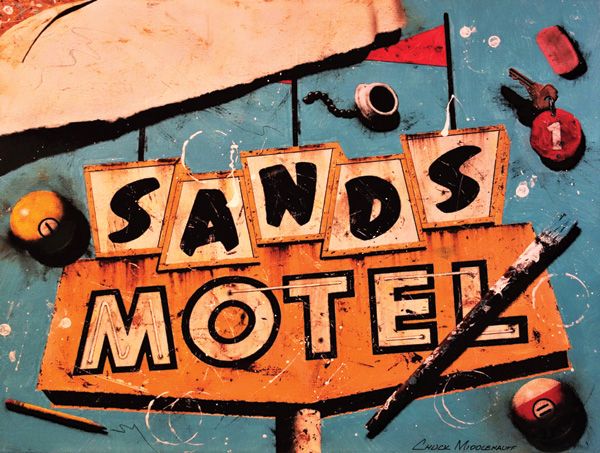
Chuck Middlekauff, Bed and Bath With Pool, acrylic, 22 x 28.
Picture an artist scraping, smudging, smearing, and scratching at his canvas, and you might think that the final products would bear evidence of that struggle. But in Chuck Middlekauff’s work, these processes enhance the impact of his weatherworn and forgotten subjects. “I want to show the old America from my childhood, but what I remember is very different from what we see now,” he says. “Things from my generation are falling down and fading away.”
Middlekauff grew up traveling around the country with his family. Now he and his wife, Carol, continue to explore the West on old back roads dotted with rundown motels, gas stations, and diners. The artist is also inspired by cowboy culture. “I like to put all these things together into a scenario that might not exist in reality,” Middlekauff says. “I want to make something unique that also brings out that nostalgia and sentimentality for the past, because everything has completely changed.” But the artist does not glaze over the elements of age that can be seen on his subjects. He adds depth and texture with tools ranging from X-Acto knives to steel wool.
Middlekauff works in both watercolors and acrylics on specially treated paper that doesn’t need to be framed under glass. He says he often uses red as a primary color in his work because of its meaning and importance in American culture. See his work at Chuck Middlekauff Studio, Austin, TX; Mountain Trails Fine Art, Santa Fe, NM; Davis & Blevins Gallery, St. Jo, TX; Tracy Miller Gallery, Manitou Springs, CO; and www.chuckmiddlekauff.com.
Maren Phillips
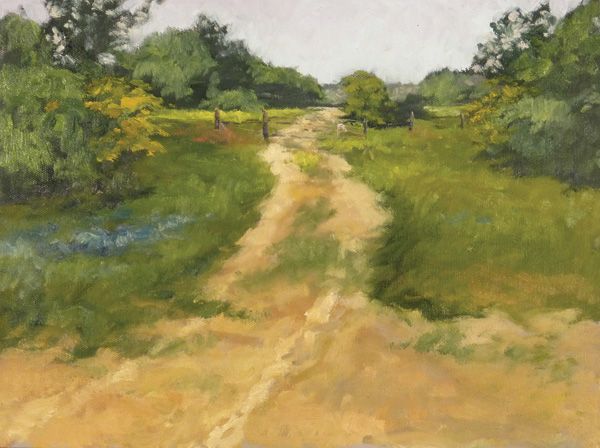
Maren Phillips, Texas Two Track, oil, 12 x 16.
Even though oil painter Maren Phillips has painted scenes and people from around the country, her passion for her Texas home is apparent in her work. And her favorite place to visit for inspiration is the state’s coastline. “You don’t have the drama of the waves crashing against cliffs like you do in other places,” Phillips says. “It has this unexplainable feeling of taking a hundred pounds of weight off your shoulders. Nothing else is going to bother you there.”
Phillips, who began her career in watercolors and portraiture, has recently shifted her focus to plein-air studies of the landscape. While she continues to paint portrait commissions, she felt the time had come to bring her work outside. Phillips describes her style as contemporary impressionism but says she is more interested in the subject rather than the techniques. “I’m trying to impress that feeling I get when I’m out there and have that show [through] in the work,” she says. This guiding principle is important when she works on her figurative pieces as well. Phillips’ main concern is staying true to the place she is painting, which she says can be seen in her piece TEXAS TWO TRACK. “That work really speaks to what South Texas looks like with all its small dirt roads,” she says. “But wherever I am, I’m painting what I see, and I want it to look true to that place and its personality.” See Phillips’ work at River’s Edge Gallery, Kerrville, TX, and www.marenphillipsartlines.com.
Tammy Lynne Penn
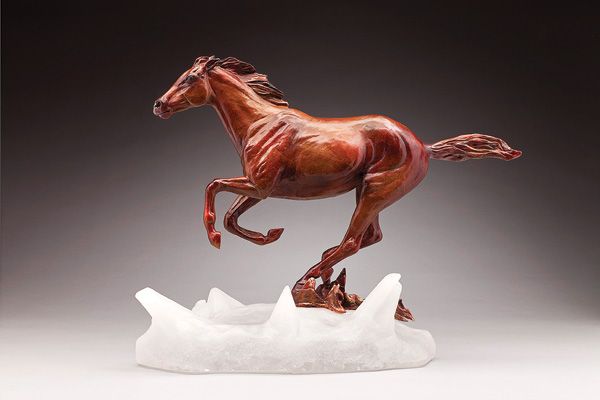
Tammy Lynne Penn, Fire and Ice, bronze/crystal, 26 x 22.
Tammy Lynne Penn is a Renaissance woman when it comes to sculpture. Her portrayals of wildlife range from regal, static poses to wild action pieces depicted in bronze, ceramic, and crystal. Sometimes she adds the branches of juniper and mesquite trees or carefully inlays pieces of turquoise. “I think it’s wonderful to have something raw from the Earth,” she says. “It’s such a contrast to the bronze and glass, which always look very finished. I’m always going back and forth between extremes.”
Although Penn dabbled in art growing up, she didn’t begin working seriously in sculpture until she visited the Sculpture in the Park show in Loveland, CO. The artist took classes at a local foundry and began casting in bronze. But the expense of the process prompted her to look for other mediums. “I wanted to find something where I could continue to practice my skills without having to cast each time,” she says. Penn experimented with raku-fired clay and, later, with glass.
Penn makes it a priority to spend time with animals, traveling on horseback for hunting trips accompanied by her falcon and hawk. “This is integral to the art,” she says. “It gives me a different perspective of being with nature, and I try to bring that feeling out through the sculpture.” See Penn’s work at Ghost Horse Gallery, Silverton, TX; T.H. Brennen Fine Art, Scottsdale, AZ; Spirits in the Wind Gallery, Golden, CO; Chisholm Gallery LLC, Wellington, FL; Beartooth Gallery, Red Lodge, MT; Kasum Contemporary Fine Art, Oklahoma City, OK; Adobe Western Art Gallery, Fort Worth, TX; Pacific Sculpture Gallery, Newport Beach, CA; and www.tammylynnepenn.com.
Rachel Dory

Rachel Dory, Blue Station (West 10 & 218, Texas), acrylic, 12 x 36.
Rachel Dory’s paintings of desolate, rural places devoid of human presence provoke quiet contemplation. Filled with straight lines, blocks of color, and distant horizons, the paintings’ subjects seem both solidly permanent and in danger of fading away. This is what Dory is pursuing: the images of Americana that seem to be disappearing.
Dory began her art career in two-dimensional ceramic work but soon moved to painting—her true passion. She began traveling throughout the country, stopping to take photographs of motels, barns, windmills, and other man-made structures in rural areas. She notes the exact locations in her titles, so that people may visit them if they wish. Working in acrylics, Dory adds multiple layers of paint to her canvas. “When I paint, I feel like I’m building,” she says. However, she will also scrape away and scrub through the layers to find new colors and textures. This subtractive process also applies to her compositions: In addition to her rural scenes, Dory paints urban images from which she omits people, cars, and other typical elements of the city. “I’m very conscious about not adding anything, even if I wish it were there,” she says. “I only take away to find the thing that drew me there because it wasn’t everything happening around it.” Dory says she enjoys both environments because of what they suggest as we travel through them. “Rural places are the in-between, with cities as the destination,” she says. “That’s exciting to me because it’s impermanent.” See Dory’s work at www.racheldory.com.
Victor Blakey
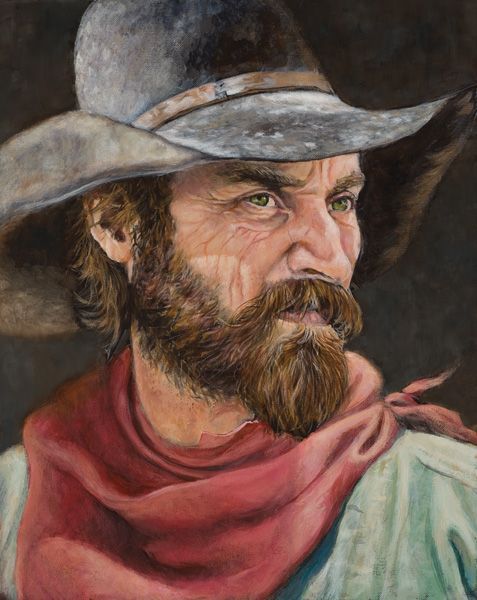
Victor Blakey, Horse Thief, oil, 20 x 16.
Although Victor Blakey began his career in portraiture, his oeuvre was soon composed largely of wildlife work. The artist studied for two years with one of his former art-school professors, building an artistic foundation in portraits before transferring his skills to paintings of bison, mountain lions, tigers, and birds.
However, Blakey has recently returned to his roots with a new focus: cowboys. “We’ve built a lot of mythology around them, and it’s almost impossible to separate that mythology from real life,” Blakey says. “I’m wanting to depict the cowboy doing that rough job that he has to do.” The artist spends much of his time working to achieve specific expressions on the faces of his subjects. “I start with an expression, and I build the painting around that,” he says. “But I try to leave a certain amount of vagueness there to give the viewer the chance to bring his own experiences.”
Blakey’s family history runs deep in Texas, and he says he feels connected to the history of the state. “The epicenter of western culture would be Texas—that’s where the West really begins, and you can feel it,” he says. The artist has participated in several shows with organizations across the country, including Oil Painters of America and the National Oil and Acrylic Painters’ Society. Blakey says he hopes to elicit an emotional reaction from viewers when they see the harsh reality of the cowboy life laid bare. “Anyone who has had to do a hard, physical job has a connection to them,” he says. See Blakey’s work at www.victorblakeyfineart.com.
Julie Asher Lee
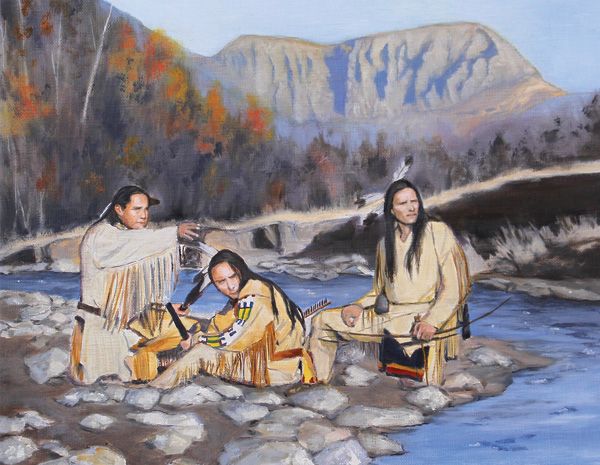
Julie Asher Lee, River Respite, oil, 11 x 14.
Julie Asher Lee, an oil painter known for her portrayals of Texas wildlife, began her career as a muralist before moving into smaller paintings and a full-time art career. However, after completing a mural for the Big Bear Native American Museum in Cleburne, TX, in 2014, the artist was struck by the images of historic Native Americans and their day-to-day lives. “We have this really interesting history in such a small period of time, but it also continues today, and it’s unique to this part of the world,” Lee says. “I was glad to be involved in the museum’s mission of keeping the younger generation involved and interested in it.”
Now, Lee has shifted her focus from wildlife to historical portrayals of different Native tribes across the West. While she continues to research tribes near her home in Texas, the artist is also traveling to Jackson, WY, and the Grand Canyon to study and paint the tribes from those areas. She has often relied on dramatic lighting in the past but says she wants to lighten her new work. “I want the atmosphere to be light and airy—I want you to feel the air in it,” she says. Lee also hopes to loosen her brushwork to help draw attention to the main subject. The artist says that with this new direction, she hopes to inspire a curiosity for Native culture in her viewers. See Lee’s work at The Bare Wall Gallery, York, England; Weiler House Fine Art Gallery, Fort Worth, TX; and www.julieasherlee.com.
This story was featured in the March 2018 issue of Southwest Art magazine. Get the Southwest Art March 2018 print issue or digital download now–then subscribe to Southwest Art and never miss another story.
MORE RESOURCES FOR ART COLLECTORS & ENTHUSIASTS
• Subscribe to Southwest Art magazine
• Learn how to paint & how to draw with downloads, books, videos & more from North Light Shop
• Sign up for your Southwest Art email newsletter & download a FREE ebook





